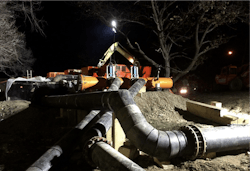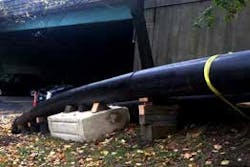Greenwich, Connecticut, located in the tristate area immediately surrounding New York City, is a scenic New England town that is home to approximately 60,000 people.
It was first settled in 1640 on a spot between the Asamuck and Patomuck Rivers, and like many historic towns, Greenwich proactively addresses aging infrastructure on a continuing basis. Its ongoing initiatives include repairs and upgrades to the town’s wastewater treatment plant and 28 pumping stations.
“Some components of our sanitary sewer and wastewater system are well beyond their expected useful life,” says Richard Feminella, Wastewater Division Manager for the Town of Greenwich, “so each year we budget for ongoing repair, replacement or upgrade projects.”
The Sewer Division of the Greenwich Department of Public Works planned to upgrade critical sewer line at multiple sewer manholes along Bruce Park Avenue, a busy roadway parallel to Interstate 95 in downtown Greenwich. Given the proximity to the town center and substantial traffic volume, the project was high-visibility and high-profile.
The upgrades included hydro-blasting deteriorating structures and installing new cement coatings. Further, 600 feet of 39-inch reinforced concrete sewer line required re-lining with a cured-in-place pipe (CIPP) liner solution. As is typical with this type of sewer line rehab, Greenwich needed a temporary sewer bypass before work commenced.
The Town’s consulting engineer, CDM Smith worked together with Xylem to develop a temporary sewer bypass plan. The Xylem-designed bypass, which would be installed by A Vitti Excavators, needed to handle nearly 17 million gallons per day (MGD) of combined flow from three sewer lines – a 24-inch gravity line, and 8-inch and 24-inch force main sewer lines – and redirect it into a 45,000-gallon temporary concrete wet well.
Solution
Xylem’s bypass design specified four Godwin diesel-driven Dri-Prime CD300M critically silenced pumps with 16-inch suction tubes from the wet well pushing flow through four 12-inch high-density polyethylene (HDPE) lines to a manifold. From the manifold, two 18-inch HDPE discharge lines ran 2,600 feet downstream of the work area. To prevent the flow from backing up into the wet well, and for efficient isolation, the system featured gate valves off each of the four pumps and check valves on the 12-inch and 18-inch lines.
The Xylem team, including two fusion technicians, cut and assembled all piping and set up the four Godwin CD300M pumps sequentially. The first pump handled the bulk of the daily flow. Pumps two and three kicked on for high-flow activity, and pump four stood by as a mechanical backup should any of the first three pumps fail.
A Godwin PrimeGuard controller operated the pumps, turning them on and off based on level transducer readings set at pre-determined levels in the wet well. An auto-dialer functioned as an added safety precaution to notify the Greenwich Sewer Division via cell phone call if the back-up pump activated. Two 500-gallon fuel cubes remained on site to easily refuel the diesel pumps.
Results
Efficiently installed in three weeks, the bypass ran for four weeks as the CIPP installation took place. Given the short timeframe of the project, Xylem’s local branch rented the bypass pumps and accessories to the Town of Greenwich. This economical arrangement enabled the Town to utilize Xylem’s expertise and secure the right pumps at a fraction of the cost required to purchase equipment.
To ensure flawless operation during this high profile and very visible upgrade, Xylem provided 24/7 pump watch for the duration of the bypass operation. Two factory-trained service mechanics performed necessary field repairs, ensured pump efficiency and monitored bypass operation.
“The whole project was pretty complex, given the different structures and lines we had to upgrade and the three lines we had to divert into the wet well,” Feminella says. “With all of this happening near the highway and the center of town, there were a lot of moving parts. But there was excellent collaboration between our staff and the team of contractors who worked through all the details, pulled it together and did a terrific job. We’ve used all three contractors in the past – CDM Smith, A. Vitti, and Xylem – so we knew they could make it happen. When a high-profile project like this gets done on time and without incident, then everyone’s happy.”
Editor's Note: Scranton Gillette Communications and the SGC Water Group are not liable for the accuracy, efficacy and validity of the claims made in this piece. The views expressed in this content do not reflect the position of the editorial teams of Water & Wastes Digest, Water Quality Products and Storm Water Solutions.

